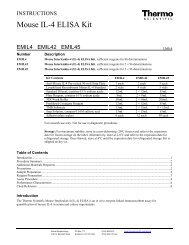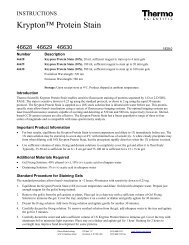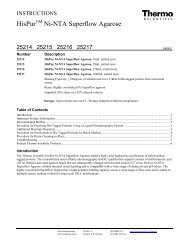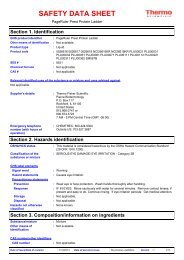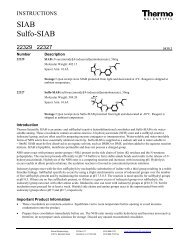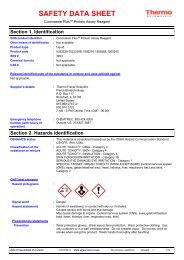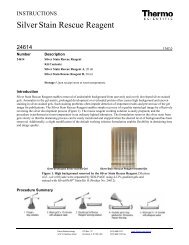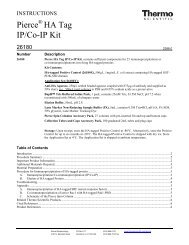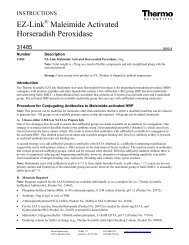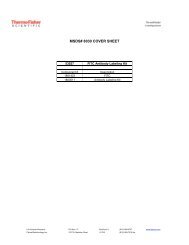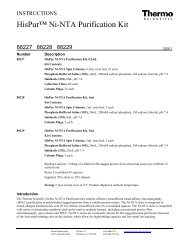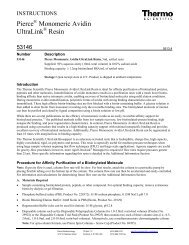Thermo Scientific Pierce Protein Assay Technical Handbook Version 2
Thermo Scientific Pierce Protein Assay Technical Handbook Version 2
Thermo Scientific Pierce Protein Assay Technical Handbook Version 2
Create successful ePaper yourself
Turn your PDF publications into a flip-book with our unique Google optimized e-Paper software.
<strong>Thermo</strong> <strong>Scientific</strong> Total <strong>Protein</strong> <strong>Assay</strong>s<br />
Pre-Diluted BSA and BGG<br />
<strong>Protein</strong> <strong>Assay</strong> Standard Sets<br />
Construct a standard curve for most protein assay methods as<br />
fast as you can pipette.<br />
solubilization of the membrane-bound proteins, biocides<br />
(antimicrobial agents) and protease inhibitors. After filtration<br />
or centrifugation to remove the cellular debris, additional steps<br />
such as sterile filtration, removal of lipids or further purification<br />
of the protein of interest from the other sample components<br />
may be necessary.<br />
Nonprotein substances in the sample that are expected to<br />
interfere in the chosen protein assay method may be removed by<br />
dialysis with <strong>Thermo</strong> <strong>Scientific</strong> Slide-A-Lyzer Dialysis Cassettes<br />
or <strong>Thermo</strong> <strong>Scientific</strong> SnakeSkin Dialysis Tubing, gel filtration with<br />
<strong>Thermo</strong> <strong>Scientific</strong> Desalting Columns or D Detergent Removing<br />
Gel, or precipitation as in the Compat-Able <strong>Protein</strong> <strong>Assay</strong>s or<br />
SDS-Out Reagent.<br />
Highlights:<br />
• Stable and sterile filtered<br />
• Ideal for BCA and Bradford-based protein assays<br />
• Standard curve range: 125-2,000µg/mL<br />
• Seven data points within the range<br />
• Sufficient materials to prepare 15-35 standard tube protocol<br />
curves or 175-350 standard microplate protocol curves running<br />
duplicate data points<br />
• Convenient – no need to prepare a diluted standard series<br />
for each determination<br />
• Consistent – no need to worry about variability in dilutions from<br />
day to day or person to person<br />
• More reliable protein quantitation because of the assured<br />
accuracy of the concentrations of each standard<br />
• Dramatically improved speed to result, especially with<br />
Bradford-based protein assays<br />
Sample Preparation<br />
Before a sample is analyzed for total protein content, it must be<br />
solubilized, usually in a buffered aqueous solution. The entire<br />
process is usually performed in the cold, with additional<br />
precautions taken to inhibit microbial growth or to avoid casual<br />
contamination of the sample by foreign debris such as hair, skin<br />
or body oils.<br />
When working with tissues, cells or solids, the first step of the<br />
solubilization process is usually disruption of the sample’s cellular<br />
structure by grinding and/or sonication or by the use of specially<br />
designed reagents (e.g., <strong>Thermo</strong> <strong>Scientific</strong> <strong>Pierce</strong> Cell Lysis<br />
Reagents) containing surfactants to lyse the cells. This is done in<br />
aqueous buffer containing one or more surfactants to aid the<br />
<strong>Protein</strong>:protein Variation<br />
Each protein in a sample is unique and can demonstrate that<br />
individuality in protein assays as variation in the color response.<br />
Such protein:protein variation refers to differences in the amount<br />
of color (absorbance) obtained when the same mass of various<br />
proteins is assayed concurrently by the same method. These<br />
differences in color response relate to differences in amino acid<br />
sequence, isoelectric point (pI), secondary structure and the<br />
presence of certain side chains or prosthetic groups.<br />
Table 2 (page 9) shows the relative degree of protein:protein<br />
variation that can be expected with our different protein assay<br />
reagents. This differential may be a consideration in selecting a<br />
protein assay method, especially if the relative color response<br />
ratio of the protein in the samples is unknown. As expected,<br />
protein assay methods that share the same basic chemistry show<br />
similar protein:protein variation. These data make it obvious why<br />
the largest source of error for protein assays is the choice of<br />
protein for the standard curve.<br />
Ordering Information<br />
Product Description Pkg. Size<br />
23208 Pre-Diluted <strong>Protein</strong> <strong>Assay</strong> Standards: Kit<br />
Bovine Serum Albumin (BSA) Set<br />
Diluted in 0.9% saline and preserved with<br />
0.05% sodium azide<br />
Includes: 7 x 3.5mL of standardized BSA solutions<br />
each at a specific concentration along a<br />
range from 125-2,000µg/mL<br />
23213 Pre-Diluted <strong>Protein</strong> <strong>Assay</strong> Standards:<br />
Bovine Gamma Globulin Fraction II<br />
(BGG) Set<br />
Diluted in 0.9% saline and preserved with<br />
0.05% sodium azide<br />
Includes: 7 x 3.5mL of standardized BGG solutions<br />
Kit<br />
each at a specific concentration along a<br />
range from 125-2,000µg/mL<br />
8<br />
For more information, or to download product instructions, visit www.thermoscientific.com/pierce



